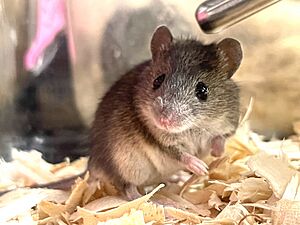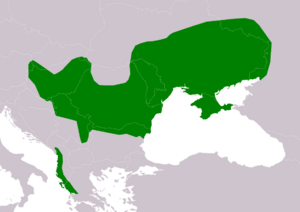Steppe mouse facts for kids
Quick facts for kids Steppe mouse |
|
|---|---|
 |
|
| Conservation status | |
| Scientific classification | |
| Genus: |
Mus
|
| Species: |
spicilegus
|
 |
|
| Range of M. spicilegus Extant, resident | |
The steppe mouse (also called the mound-building mouse) is a small rodent. Its scientific name is Mus spicilegus. It belongs to the Muridae family, which includes mice and rats. You can find these mice living in grassy areas and open fields. They live in many countries across Europe. These include Austria, Bosnia and Herzegovina, Albania, Bulgaria, Croatia, Czech Republic, Hungary, North Macedonia, Romania, Serbia, Montenegro, Slovakia, Slovenia, and Ukraine.
Contents
About the Steppe Mouse
The steppe mouse lives across a wide area. This range stretches from Austria to southern Ukraine and Greece. There are two main types, or subspecies, of this mouse. One type, M. s. spicilegus, lives in most of its known range. The other, M. s. adriaticus, lives only along the Adriatic coast.
The steppe mouse is related to other mice in the Mus group. These include the Macedonian mouse, the Algerian mouse, and the Cypriot mouse. These mice all live in the western Palearctic region.
What Does the Steppe Mouse Look Like?
The steppe mouse is a small animal. Its body, from head to tail base, is about 70 to 80 millimeters (2.8 to 3.1 inches) long. Its tail is a bit shorter, measuring 55 to 65 millimeters (2.2 to 2.6 inches).
Most steppe mice are a plain grey color. They do not have any reddish fur. However, some groups of these mice have lighter fur on their bellies. Their tails are thinner than those of similar mouse species.
The steppe mouse looks very much like the common house mouse (Mus musculus). Because of this, people often confuse them. The biggest difference is how the steppe mouse builds mounds. But you can only see these mounds at certain times of the year.
Life and Habits of the Steppe Mouse
Steppe mice live in many open areas. These include grasslands, steppes, and even farms. They can also be found in orchards and at the edges of forests.
Mound Building Behavior
One special thing about the steppe mouse is its habit of building large mounds. They do this in the autumn. Several mice work together to build these mounds. The mounds can be up to 4 meters (13 feet) wide. However, they are usually 1 to 2 meters (3 to 7 feet) wide.
About four to fourteen mice cooperate to build a mound. These mice are often closely related, usually through their mother's family. The mound covers special storage rooms underground. These rooms can hold up to 10 kilograms (22 pounds) of seeds and grains. Below the storage rooms is a cozy nesting chamber.
You might find up to twenty mounds in one hectare (about eight per acre). But in places with lots of food, there can be many more.
Reproduction and Life Cycle
Steppe mice breed during certain seasons. This usually happens between March and October. Young female mice, about six to eight months old, spend the winter in the mounds. They start breeding in the spring. A female mouse can have four or five litters of babies in a year. In central Ukraine, a litter usually has about 6 or 7 young mice.
During the summer, most steppe mice live in simple burrows. But some mice continue to live in the mounds. If a mound stays in good shape, it might be used again in the autumn for winter.
New mounds are built from mid-August to mid-November. This is when cereal crops and other plants are producing seeds. Young mice, about three to four weeks old, do most of the building. The mound becomes their home for the winter. Adult mice sometimes share these homes too. Building a mound usually takes two or three weeks. The size of the mound depends on how many mice are helping and how much food is available. Scientists have found seeds from 84 different types of plants stored in these mounds!
Conservation Status
The steppe mouse is a common animal. It lives in many places. The International Union for Conservation of Nature (IUCN) says it is a "least concern" species. This means it is not currently at high risk of disappearing. However, the IUCN also notes that modern farming methods and the loss of grassy steppes could be a problem for these mice in the future.


